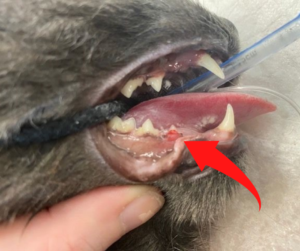
Cats get a very different kind of dental disease to dogs. Very small invisible holes in the tooth allow bacteria to enter and start to dissolve the tooth from the inside. Often there are no signs to see externally – maybe just a red blob of gum at the edge of the tooth and gum line. These teeth look normal from the outside but are completely dissolved on the inside with the roots involved in most cases as well. Often times the tooth appears normal to the casual cat observer but the entire root system has rotted and resorbed away leaving just the shell of a tooth to see. When the top, or crown of the tooth is involved – the lesions are painful. When just the roots of the tooth are involved pain may not be obvious – but we know from studies in humans with similar holes in their teeth – they are definitely painful.
(FORL) are extremely common and only affect cats. The teeth dissolve from the inside.
The best way to check for these lesions is for the vet to use an explorer to check for small cracks or holes at the gum line. Ultimately xrays of the teeth are needed to discover hidden problems inside the tooth.
In the example below, you’ll see the affected tooth is the lower second premolar (cats don’t have a first premolar on the lower jaw) which has a red line across the base of it.

Signs and Symptoms of Tooth Resorption
Cats hide their pain very well, so signs can be subtle.
Cats will continue to eat with these painful dental problems. There are often no symptoms until we examine with a probe. Teeth chattering or broken food all around the food bowl can hint at dental pain. You may notice increased salivation or changes in your cat’s food preferences (for example a reluctance to eat hard foods such as kibble or biscuits.)
Other signs may include redness of the gums or holes in the teeth which may go unnoticed unless you regularly examine your cat’s mouth. For this reason, we offer free regular dental checks for all of our patients.
Treatment
The best treatment for tooth resorption is to remove the affected teeth. This helps to avoid infection and other complications. We always x-ray all the teeth before we make a decision as to which teeth need extraction or treatment.
We use regional nerve blocks of a local anesthetic to ensure your cat’s mouth is pain-free at home time, and provide pain relief for home. Antibiotics are not needed as we remove all affected and infected tissue.
Prevention
Cats who have had tooth resorption diagnosed previously will very likely develop additional lesions in the future, so it’s important to maintain regular dental check-ups.
For more information about our free dental checks or to book an appointment, please call us on 9561 2438 or book online.
